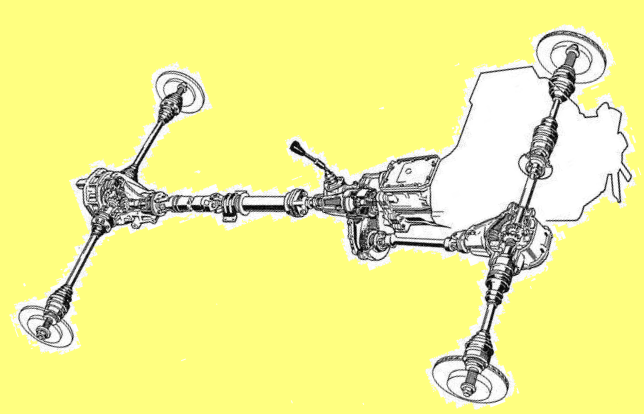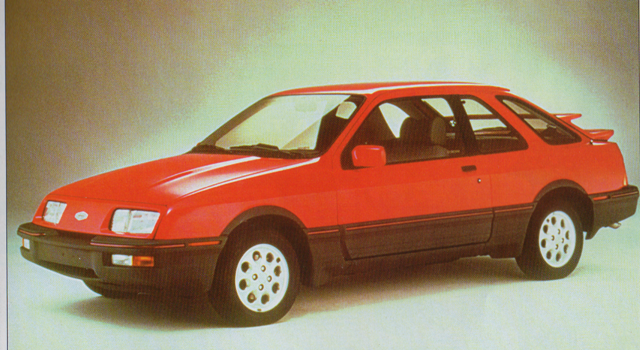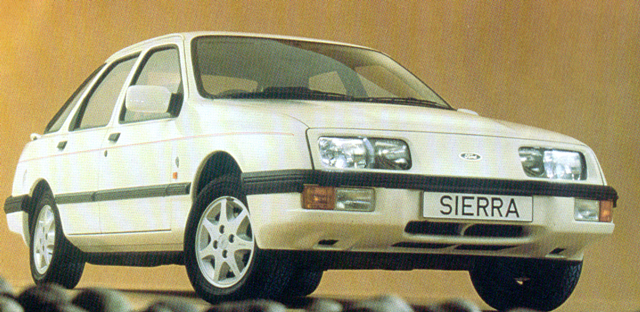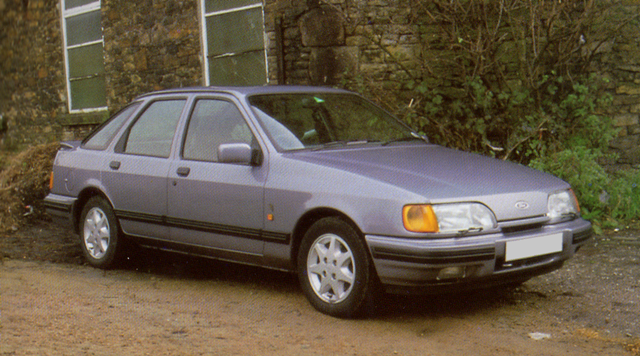XR4x4
| The Sierra XR models started in 1983 with the launch of the XR4i. Powered by the 2,792cc Cologne V6 engine from the Capri with Bosch K-Jetronic fuel injection and driving through a T9 gearbox to the rear wheels, it was distinctive with its grey lower body-side cladding, 14” pepperpot wheels and ‘biplane’ rear spoiler. It was also the only Sierra to use the 3-door 8-lite shell with its unique split rear side window arrangement. Power was a conservative (for a V6) 150bhp, but the emphasis was always on torque with this engine at 161lb/ft, and because the engine is so under-stressed at this power level they can easily go on for hundreds of thousands of miles if carefully maintained. | © Ford Heritage Magazine, 1993 |
|
© Ford Heritage Magazine, 1993 |
This was followed up in 1985 by the MK1 XR4x4 model, still using the same 2.8 engine and gearbox but now driving through a Ferguson designed four-wheel-drive system, the details of which are explained at the bottom of the page. The styling was much subdued from the earlier XR4i, as the car was aimed more at the ‘family man’ rather than the sporting type. The shell used was the same 5-door version as the rest of the range, at least in appearance. Underneath however the floorpan was different to allow extra clearance for the transfer box and front propshaft, and the front chassis rails now had cut-outs in them to allow for upward movement of the front driveshafts. On the surface the plastic bodykit of the XR4i had gone along with the biplane rear spoiler, to be replaced with a much more discreet rubber lip-spoiler. Antilock brakes were now an optional extra and the wheels fitted were 7-spoke 14” items similar to the 15” version fitted to RS Turbo and RS1600i Escorts. |
|
| In 1987 the hatchback underwent a facelift to give a more family appearance with the new 4-door Sapphire models, with restyled front and rear ends the main features. The XR4x4 continued to be offered only in 5-door hatch form, with the main changes going on under the bonnet. The Cologne V6 remained, but from 1989 it came in 2,933cc form with electronic fuel-injection under Ford EEC-IV management and better designed 6-port cylinder heads, as opposed to the siamesed ports of the earlier 2.8, something which restricted tuning options to a certain extent. Quoted power remained the same at 150bhp, but a slight increase in torque at 172lb/ft was the result of many internal changes. The gearbox was also replaced by the new MT75 unit with its more positive change, but unfortunately with ratios not really suited to the V6 resulting in the car not being able to hit the magic 60mph in 2nd gear at the standard 6,000rpm rev limit. Another minor update in 1990 saw some cosmetic changes with 14” 5-spoke alloy wheels, thinner side rubbing strips, smoked rear lights, and clear front indicators, plus a rear spoiler raised on ‘legs’ similar to the Sapphire RS Cosworth item but without the pronounced rear lip. A 2-litre version was also offered using the 123bhp 8-valve twin-cam I4 engine from the Ghia and 2000E, with a choice of 4x4 transmission or RWD only badged as an ‘XR4i’. 1991 saw the engine fitted with a catalytic convertor to comply with new emissions legislation and a move to 15” wheels. More cosmetic changes came along with a different dashboard arrangement and new paint colour options before the Sierra was discontinued in 1993. | © Windrow & Greene Automotive, 1992 |
|
 |
The 4WD system consists of a transfer box attached to the rear of the existing gearbox with a chain drive powering a forward-facing propshaft into the front differential, which is itself bolted to the side of the modified sump. The offside has a simple direct driveshaft from the diff to the front hub, whilst the nearside has a bearing-mounted transfer shaft running in a tube through the sump to the driveshaft. This ‘equal-length driveshaft’ arrangement stops the transmission of power having a negative effect on the steering, something that can be felt far more in powerful front-wheel-drive cars as the torque fights the efforts of the driver to keep the car in a straight line! It also makes for a very neat package. The epicyclic gears in the centre differential split power 66% to the rear and 34% to the front, with a viscous coupling which progressively 'locks up' to make the split more approaching 50/50 should the rear wheels start to spin. This gives the car a more ‘RWD feel’ preferred by enthusiastic drivers, instead of the fixed 50/50 split of some other 4WD performance cars that have gained a reputation for chronic understeer! The rear differential was also now fitted with a viscous coupling to aid traction, although the front diff remained of the open type. |
© Sprintex-net 2011 - Go to Sprintexnet home


